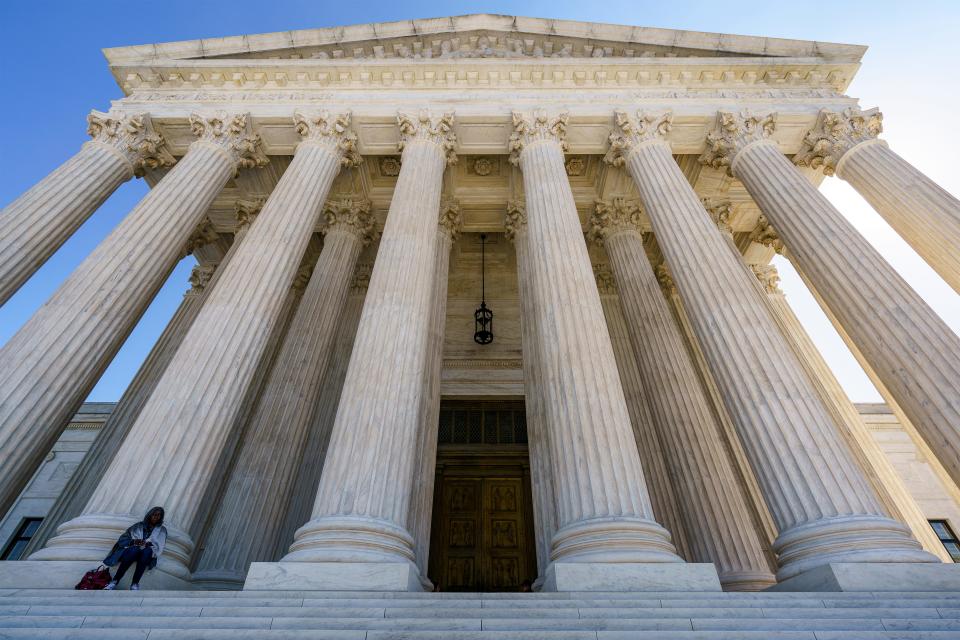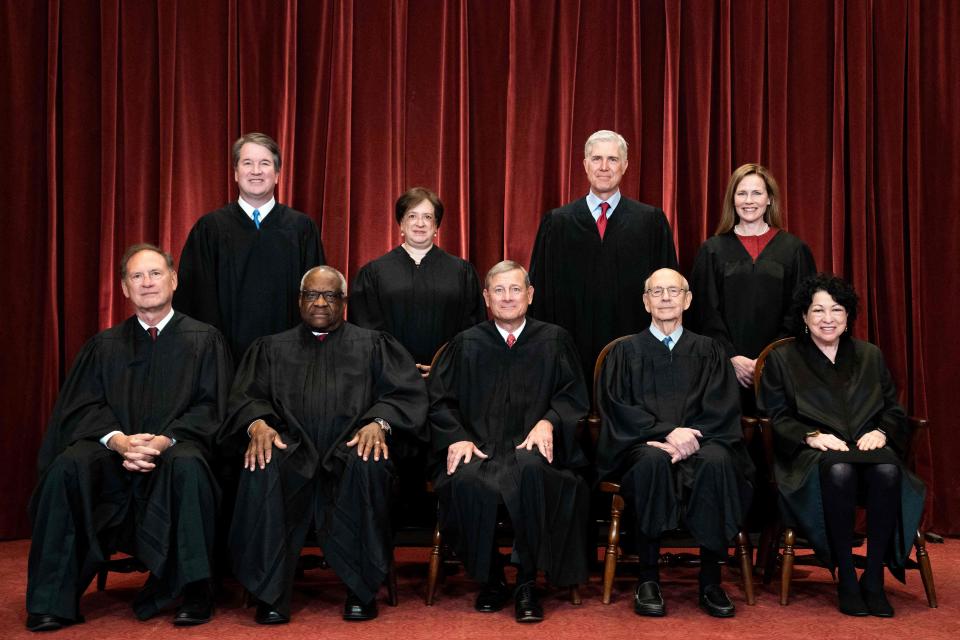Justice Breyer's new book warns against meddling with the Supreme Court. But he's wrong.
- Oops!Something went wrong.Please try again later.
- Oops!Something went wrong.Please try again later.
- Oops!Something went wrong.Please try again later.
- Oops!Something went wrong.Please try again later.
- Oops!Something went wrong.Please try again later.
U.S. Supreme Court Justice Stephen Breyer's latest book is the size of the palm of my hand and has only 100 pages. "The Authority of the Court and the Peril of Politics" was released Tuesday amid calls for Breyer's retirement.
Breyer, 83, who has been on the court for 27 years, argues against political intervention in the highest court in the land, warning that partisan meddling would further "erode public trust."
While I have been a fan of Justice Breyer's writing since law school, this time he is wrong. And the court's most recent decision (in which Breyer dissented) to clear the way for a Texas law that essentially ends access to legal abortion is a perfect illustration of why the court's power has become unwieldy.
In the book, Breyer defends our federal judicial way of life, specifically that of the Supreme Court, providing oversimplified arguments without answering questions he poses himself: "Do appointments too closely reflect partisan political divisions?" And, "Has the Court itself become politically partisan?"
The answer is a resounding "Yes!"
Opinions in your inbox: Get a digest of our takes on current events every morning
As the Proud Boys march on main streets, as police continue to gun down Black people and get away with it, and in the aftermath of the Jan. 6 insurrection at the U.S. Capitol, Breyer's concerns of an inflammatory political hijacking of the court is understandable and even honorable. But allowing the court to continue as it is now is untenable.
We are an evolving nation, these are pivotal times, and the federal judiciary desperately needs a makeover.
Breaking half a century of precedent
One of the great fallacies of the American common law system is to believe that a judge can be impartial.
Allowing the Texas law to stay in place while parties litigate its constitutionality clearly shows that this court is far from objective. With President Donald Trump's three appointees and Justice Clarence Thomas on the bench, the six conservative justices are determined to rally against nearly 50 years of progressive judicial precedent in favor of a far-right ideology that subjugates women's rights to those of a second-tier citizen or, in the words of former Justice Ruth Bader Ginsburg, "less than a fully adult human responsible for her own choices."

To put that into context, the last time the Supreme Court overturned half a century of precedent was in Brown v. Board of Education, in which the Warren court held the apartheid-esque doctrine of "separate but equal" as unconstitutional.
In his book, Breyer references historic problems of a lack of judicial authority that this nation once faced as warnings that any meddling with the court could erode the check and balance that the judiciary provides on the other two branches of government.
But that is no longer an issue. Instead, a weak judiciary has been gradually replaced with borderline judicial tyranny – with three justices, nominated by the nation's worst president, sitting for "life" as they push through right-wing agendas on their procedural or "shadow" docket, which means cases get decided without oral argument, or full briefing.
Court packing isn't something we have to worry about in the future. It has already happened, and now we need to deal with it. Justice Amy Coney Barrett grabbed her seat on the court immediately after the death of Ginsburg, and just weeks out from the presidential election. Meanwhile, President Barack Obama had 10 months left in his term when he made a nomination in March 2016 – well before the presidential election – to replace the seat vacated by Justice Antonin Scalia's death; Republicans blocked his nomination, arguing it was too close to the election.
Not to mention the hypocrisy of Republicans, who ranted for years about judges legislating from the bench when Justices Elena Kagan and Sonia Sotomayor were appointed. Those same Republicans are now silent as a 6-3 supermajority, ultraconservative court pushes through significant, polarizing and retrogressive legislation on a questionable shadow docket.

The United States is also the only major democracy to give life tenure to the justices on the nation's highest court. Lifetime appointments are for dictators and authoritarians, not the U.S. judiciary. Organizations like the Center for American Progress have worked on proposals to reform the federal judiciary. Setting term limits, something Breyer has said he could support, would be an easy way to start.
Twenty years on the bench would be enough time to insulate justices from the undue influence of changing political regimes in Congress or in the White House, as Breyer is correct to warn us of in his book.
Problems with the U.S. Supreme Court
That we have nine justices on the Supreme Court is also hardly set in stone. In fact, the number of justices changed six times before reaching nine in 1869.

After winning his second presidential term, Franklin Roosevelt – furious that the Supreme Court had struck down 11 of the 13 New Deal laws he had put forth, and mostly by a 6-3 margin – FDR put together the 1937 Judicial Procedures Reform Bill and moved to appoint up to six additional justices.
The effort failed, but some analysts argue that the threat was enough to sufficiently spur Justice Owen Roberts and the court into upholding his New Deal legislation, the so-called switch in time that saved nine.
Today, with Democrats controlling Congress, and Vice President Kamala Harris holding the tie-breaking vote in the Senate, adding more liberal justices (with term limits) to the bench could provide a check and balance on ideologue justices who have hijacked the court from under our noses and are determined to overturn decades of progressive judicial precedent.
Marva Sadler: Inside our clinic, I watched the Texas six-week abortion ban unfold in real time
We also have two men – Justices Clarence Thomas and Brett Kavanaugh – who have had serious allegations of sexual assault and harassment leveled at them. Yet they are actively making decisions about women's rights that could fundamentally change women's ability to access essential health care in GOP-controlled states across the country.
Kristan Hawkins: Victory for children: Texas abortion law sets great pattern for other states to follow
There is also political will among Democrats to push for reform.
Earlier this month, Rep. Alexandria Ocasio-Cortez, D-N.Y., tweeted, "Republicans promised to overturn Roe v Wade, and they have. Democrats can either abolish the filibuster and expand the court, or do nothing as millions of peoples’ bodies, rights, and lives are sacrificed for far-right minority rule."
At a critical crossroads in history
It is undeniable that we are at a critical juncture in this nation's history. We have a Supreme Court run amok, and we must act to rein it in before we have to write the obituary of Roe v. Wade and pave the way for a hyperconservative majority to wreak havoc on our legal system, our democracy and on women.
Justice Breyer has been a bold, brilliant voice for progress and justice for nearly three decades – but the court needs to evolve, and he needs to make way for the change.
The overwhelming evidence in favor of judicial reform is not merely a notion that can be explained away in 100 pages.
Carli Pierson is an attorney and opinion writer for USA TODAY. Follow her on Twitter: @CarliPierson
You can read diverse opinions from our Board of Contributors and other writers on the Opinion front page, on Twitter @usatodayopinion and in our daily Opinion newsletter. To respond to a column, submit a comment to letters@usatoday.com.
This article originally appeared on USA TODAY: Supreme Court: Justice Breyer's book gets it wrong. Time to reform.

